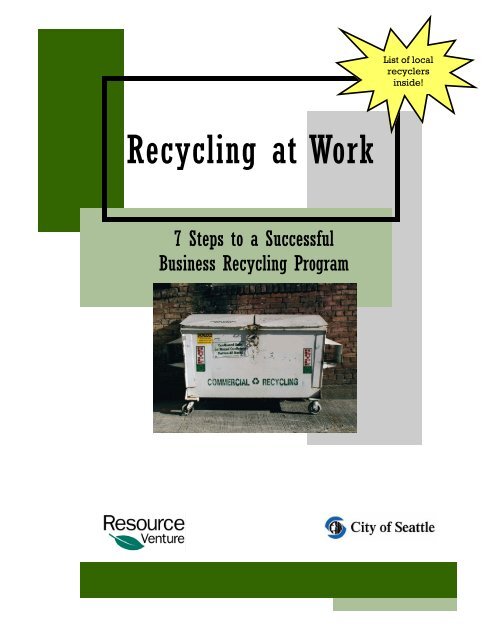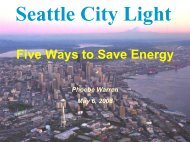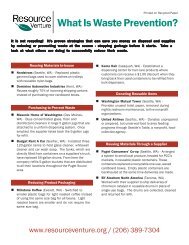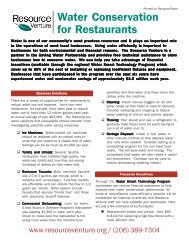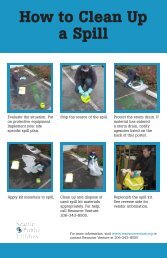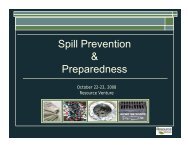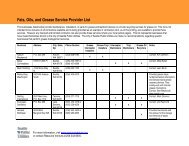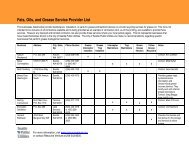7 Steps - Updated.pub - Resource Venture
7 Steps - Updated.pub - Resource Venture
7 Steps - Updated.pub - Resource Venture
You also want an ePaper? Increase the reach of your titles
YUMPU automatically turns print PDFs into web optimized ePapers that Google loves.
Recycling at Work<br />
7 <strong>Steps</strong> to a Successful<br />
Business Recycling Program<br />
List of local<br />
recyclers<br />
inside!
This guide was prepared by the <strong>Resource</strong> <strong>Venture</strong> in September 2004 and updated in December 2005. The<br />
<strong>Resource</strong> <strong>Venture</strong> is a program of the Greater Seattle Chamber of Commerce in partnership with Seattle Public<br />
Utilities.<br />
To request permission to reproduce any of the information found in this guide, please contact the <strong>Resource</strong> <strong>Venture</strong><br />
at (206) 343-8505.<br />
The clip art used was generously donated by a number of agencies who paid for the original commission of the<br />
artwork. The donors include the Association of Oregon Recyclers, the California Integrated Waste Management Board,<br />
the City of Portland, METRO, the Minnesota Office of Environmental Assistance and DEQ.<br />
www.resourceventure.org (206) 343-8505
Table of Contents<br />
Seattle’s Recycling Regulations 1<br />
Frequently Asked Questions 1<br />
7 <strong>Steps</strong> to a Successful Business Recycling Program 4<br />
Setting Up a Successful Business Recycling Program<br />
Step 1: Select a Recycling Coordinator 5<br />
Step 2: Gain Management Support 5<br />
Step 3: Determine What to Recycle 6<br />
Step 4: Select a Recycler 6<br />
Step 5: Set Up a Collection System 8<br />
Step 6: Promote Your Program 9<br />
Step 7: Keep It Growing 10<br />
Composting Food and Yard Waste 11<br />
Preventing Waste in the First Place 13<br />
Appendix A—Waste Inventory & Paper Estimation Worksheets 15<br />
Appendix B—Recycling Collection Service Providers 16<br />
Appendix C—Sample Recycling Container Labels 19<br />
Appendix D—Seattle Recycling & Disposal Stations 20
Seattle’s Recycling Regulations<br />
Seattle spends more than $26 million every year to send 920 million<br />
pounds of garbage to a landfill, where it will sit for thousands of years.<br />
About 25% of that garbage is made up of paper, cardboard, aluminum<br />
cans, plastic bottles and yard debris that could have been recycled or<br />
composted.<br />
Page 1<br />
Why waste a good thing? That’s what Seattle Mayor Greg Nickels and City<br />
Council members asked when they passed an ordinance that aims to save residents and businesses<br />
as much as $2 million a year and keep future garbage costs low. Ordinance 121372 bans certain<br />
materials from the garbage and requires they be recycled instead. It is also the first in a series of<br />
steps and programs designed to increase Seattle’s recycling rate, conserve resources and lower the<br />
cost of doing business.<br />
City of Seattle Ordinance 121372 prohibits:<br />
Businesses from disposing of paper, cardboard or yard waste in the garbage.<br />
Exception: food-soiled or otherwise contaminated paper and cardboard.<br />
Residents (both single-family and multi-family) from putting paper, cardboard, glass and plastic<br />
bottles and jars as well as aluminum and tin cans in their garbage containers.<br />
Exception: food-soiled or otherwise contaminated paper and cardboard.<br />
Frequently Asked Questions<br />
Why is the City of Seattle requiring recycling?<br />
This approach was adopted when – after 15 years of voluntary recycling and educational programs –<br />
it was clear that the City of Seattle would not reach its recycling goal of 60%. The business<br />
community's decreasing recycling rate is seen as one reason for the City's failure to reach its goal.<br />
Consequently, recyclable paper and cardboard (a large portion of the disposed commercial waste<br />
stream) and yard waste (prohibited from residential garbage since 1989) were targeted.<br />
How will the City enforce this ordinance with businesses?<br />
After two years of education, the City of Seattle started enforcing the recycling ordinance on January<br />
1, 2006. If a commercial customer has significant amounts of recyclables in their garbage, they will<br />
receive two warning notices before being issued a $50 fine.<br />
What is considered “significant amounts of recyclable materials?”<br />
“Significant amounts of recyclables” means a commercial garbage container or self-haul vehicle's<br />
load that contains more than 10% recyclables by volume (specifically paper, cardboard and yard<br />
debris – either alone or in combination) based on a visual inspection by a SPU inspector, contractor<br />
or transfer station worker.
Page 2<br />
Will our janitorial service have to go through the garbage and pull out recyclables?<br />
The City is not expecting janitors or housekeeping staffs to pull out paper and cardboard that<br />
tenants, employees and/or guests (e.g., hotels) throw away. The City, however, does expect<br />
businesses to provide tenants, employees and/or guests with recycling containers, and to give them<br />
instructions on the means of recycling. Such notice should include mention that recycling is a City<br />
requirement.<br />
Additionally, the City may not hold a business responsible if the <strong>pub</strong>lic throws paper and cardboard<br />
into their street-side, non-locking garbage containers, assuming certain conditions outlined in the<br />
ordinance are met.<br />
What if we don’t have space outside for a recycling container?<br />
Commercial customers may be exempt if a SPU inspection determines that there is not adequate<br />
space for recycling on site and no opportunity exists for sharing recycling containers with neighboring<br />
businesses or apartments. The inspection must be requested by the customer.<br />
Will having a recycling collection service cost us more money?<br />
Recycling generally reduces a business’ total disposal costs. The savings in lower garbage bills<br />
normally covers any fee you may pay for recycling collection. Here’s the key: When you keep<br />
recyclable materials out of the garbage, your waste container will be less full. Don't pay to have<br />
empty space hauled away. Rather, ask your garbage hauler to reduce the size of your container<br />
and/or pick it up less frequently.<br />
Not all recyclers charge a fee for recycling. Generally, if a business or building generates a large<br />
quantity of materials that the recycler can resell at a good price, then the recycling company will<br />
pick up the materials for free. In these cases, you may also get a rebate for the value of these<br />
materials. Keep in mind, however, that recyclable materials are commodities and, as a result,<br />
their value fluctuates.<br />
Commodities that some recyclers will purchase are white office paper and cardboard. If your<br />
building generates large quantities of these materials, call a variety of recyclers to find out which<br />
one will give you the best price for your materials.
In a multi-tenant building, who will be held responsible for paper,<br />
cardboard or yard debris in the garbage?<br />
The subscriber of the garbage account is responsible. If the building owner<br />
pays the garbage bill and provides solid waste services for all of the building<br />
tenants, then he/she is the garbage subscriber. If the building owner<br />
contracts with a property management company and that property manager<br />
pays the garbage bill and provides solid waste services for all of the building<br />
tenants, then the property management company is the garbage subscriber.<br />
If an individual tenant, like a restaurant, sets up its own, independent<br />
garbage account, then the tenant is the garbage subscriber.<br />
Page 3<br />
Generally, your business or building is complying with the ordinance if you:<br />
1) Provide all tenants, employees and/or guests with recycling containers for recyclable paper and<br />
cardboard.<br />
2) Instruct them to recycle paper and cardboard and let them know that it is a City requirement.<br />
3) Compost yard debris by either having it hauled away for composting or by composting it on site.<br />
4) Maintain 10% or less (by volume, alone or in combination) recyclable paper, cardboard and yard<br />
debris in your garbage containers or self-haul loads taken to the City’s Recycling and Disposal<br />
Stations.<br />
To read the SPU Administrative Rule, which outlines the details of Ordinance 121372, visit<br />
www.resourceventure.org/rv/issues/waste/rec-ord/index.php or contact the <strong>Resource</strong> <strong>Venture</strong><br />
at (206) 343-8505 or help@resourceventure.org.<br />
What happens to the materials we recycle?<br />
Your recycled paper, cardboard, plastic and glass bottles and aluminum and tin cans are processed,<br />
bundled and sold to manufacturing plants around the Northwest and all over the world. For example,<br />
recycled paper and cardboard are turned into everyday items like boxes, tissue paper and<br />
newspaper. Additionally, recycled plastic bottles are made into many products, including t-shirts,<br />
fleece clothing, polyester carpet, toys and, of course, new bottles. Lastly, aluminum cans are used to<br />
make cars, appliances and new cans. In fact, manufacturers can make a new can out of a recycled<br />
aluminum can in as few as 90 days!
7 <strong>Steps</strong> to a Successful Business Recycling Program<br />
Page 4<br />
STEP 1: Select a Recycling Coordinator<br />
An effective business recycling program needs an enthusiastic coordinator with organizational<br />
experience and good communication skills. The coordinator should have good staff rapport and a<br />
thorough understanding of recycling and City of Seattle recycling requirements.<br />
STEP 2: Gain Management Support<br />
Support from upper management is crucial if your program is to succeed. Even though commercial<br />
recycling is mandatory, it is still important for everyone to know that upper management is serious<br />
about complying with Seattle’s new ordinance.<br />
STEP 3: Determine What to Recycle<br />
Although businesses are only required to recycle paper, cardboard<br />
and yard debris, if your business generates other recyclables, like<br />
aluminum cans or plastic bottles, set up a program for these<br />
materials too. It will take little extra effort and most recyclers<br />
already accept these common materials.<br />
STEP 4: Select a Recycler<br />
Once you have determined which materials to recycle, select a<br />
recycler that collects those materials. There are a number of<br />
companies that offer recycling collection service in Seattle. Shop<br />
around and find the service that best meets your needs. For a list<br />
of local recyclers, see Appendix B.<br />
STEP 5: Set Up a Collection System<br />
A simple and convenient collection system will result in greater<br />
employee participation. Well-marked recycling containers placed at<br />
every desk and in other common work areas (where large<br />
quantities of material are generated) will enable you to collect the greatest volume of recyclables. Be<br />
creative! Design a system unique to your business’ needs.<br />
STEP 6: Promote Your Program<br />
Promotion is the key to all successful recycling programs and well-informed employees will actively<br />
participate. Up-front education and planning will help ensure that you have fewer implementation<br />
problems. Involve your staff in promotion and planning so that they have some ownership in the<br />
program. Promote your new program through a kick-off event and employee training sessions.<br />
STEP 7: Keep It Growing<br />
Don’t stop once you’ve implemented a successful recycling program. Work to continuously expand<br />
and improve your system. Reinforce the new recycling habit in your company and don’t forget to<br />
train new employees. Use your employee newsletter or send out emails with information about how<br />
the program is doing. Let staff know what volumes they are recycling and address any problems.<br />
Add new, less-common materials to your recycling program.
Setting Up a Successful Business Recycling Program<br />
Now that you are familiar with the seven steps, each will be discussed in more detail.<br />
STEP 1:<br />
Select a<br />
Recycling<br />
Coordinator<br />
Page 5<br />
An effective business recycling program needs an enthusiastic<br />
coordinator with organizational experience and good communication<br />
skills. The coordinator should have good staff rapport and a thorough<br />
understanding of recycling and City of Seattle recycling requirements.<br />
Depending on the size of your company, the coordinator will spend a<br />
day or two to a couple of weeks getting the program off the ground.<br />
Once it’s running smoothly, no more than a couple hours a month will be needed to monitor the<br />
program.<br />
The coordinator is responsible for:<br />
Selecting a recycler and working with them to develop the collection system<br />
Getting and distributing containers<br />
Creating a promotion and education campaign and answering questions<br />
Working with department supervisors to help them encourage employee participation<br />
Tracking and reporting on the progress of the program<br />
Acting as liaison with the recycling company and the janitorial staff<br />
An alternative approach, especially if this seems like too much work for<br />
one person, is to organize a company-wide or building-wide Green Team.<br />
A Green Team is a group of employees or tenants that are responsible for<br />
planning, setting up and maintaining the building’s waste prevention and<br />
recycling programs.<br />
The Team should represent a cross-section of the employees or tenants of<br />
the facility. In multi-tenant situations, this might mean a representative of<br />
each company in the building; in large institutions, this may be a<br />
representative from each department. Whatever the makeup, it is<br />
essential for you to recognize that an integrated approach to planning will<br />
assure a successful program.<br />
STEP 2:<br />
Gain<br />
Management<br />
Support<br />
In the long term, support from upper management and your co-workers<br />
is key. After all, you can’t do it alone; you need the participation of all<br />
employees to make your program work.<br />
Discuss the potential for recycling with the facility, office or building<br />
manager to get his or her support for organizing a program.<br />
Talk with others in your organization or send out a support-building<br />
memo describing the new program.<br />
Recruit volunteers from various departments for a “Green Team.”
STEP 3:<br />
Determine<br />
What to<br />
Recycle<br />
Page 6<br />
The City of Seattle requires businesses to recycle mixed paper,<br />
cardboard and yard debris. If you don’t already recycle these materials,<br />
you need to start. If you are already recycling these materials, why not<br />
expand your program to include other materials like aluminum cans and<br />
plastic bottles? It will take little extra effort and most recyclers already<br />
accept these common materials.<br />
To determine if there are other recyclable materials in your garbage, conduct a simple waste audit. A<br />
waste audit is a procedure to guide your recycling coordinator or Green Team through a series of<br />
steps, which will provide data on how much waste is generated, disposed of and recycled. You can<br />
use the sample Waste Inventory and Paper Estimation Worksheets in Appendix A or simply estimate<br />
by taking a peek in your company’s dumpster.<br />
STEP 4:<br />
Select a<br />
Recycler<br />
Now that you know which materials you’d like to recycle, compare the<br />
services of several local recyclers. Before you call, fill out the table<br />
below so you’ll be ready to answer many of the questions a recycler will<br />
likely ask.<br />
Question Answer<br />
Types of materials you’d like to recycle? Mixed Paper<br />
Cardboard<br />
Yard Waste (if applicable)<br />
Aluminum cans<br />
Plastic bottles<br />
Glass bottles & jars<br />
________________________<br />
________________________<br />
A rough estimate of the amount of those materials<br />
generated in a month (gallons, cubic yards, etc.)?<br />
Size of building (# of floors or sq. footage)?<br />
Number of employees in your company / number of tenants<br />
in your building?<br />
Available storage space for recyclables?<br />
Building access for pick-up (loading dock, off-street parking,<br />
alley access, etc.)?<br />
Is your janitorial staff prepared to implement your recycling<br />
program?<br />
Your current garbage service level (i.e., the size of your<br />
container and the frequency of pick-up)?
Page 7<br />
Contact several recyclers from the Recycling Collection Services fact sheet in Appendix B. While<br />
you’re on the phone, ask the following:<br />
Service Options Recycler #1 Recycler #2 Recycler #3<br />
Will the recycler do a waste audit to help<br />
identify recyclables?<br />
What materials does the recycler<br />
collect? Is there a minimum quantity for<br />
pick-up service?<br />
What is the collection schedule? How<br />
flexible is it?<br />
What are the charges, if any, for the<br />
service?<br />
Will they pay for materials collected?<br />
If you have confidential documents, will<br />
the recycler guarantee destruction or<br />
assume liability? Will there be a fee for<br />
this additional service?<br />
Containers & Equipment<br />
Will the recycler provide containers or<br />
equipment? What types?<br />
What are the costs, if any?<br />
Are there other options for purchasing,<br />
leasing or obtaining containers? Would<br />
it be cost effective to purchase a baler<br />
or crusher?<br />
Will the recycler provide signage for the<br />
containers?<br />
Collection & Storage<br />
Do the recyclables need to be separated<br />
into different containers or can they be<br />
combined for collection?<br />
Does the recycler have specific<br />
requirements for storage and pick-up?<br />
Special Services<br />
Will the recycler provide reports with<br />
materials and volumes recycled?<br />
Will they provide training for employees?<br />
Will the recycler come on site and setup<br />
the program?
Page 8<br />
Once you’ve set up the program with your recycler, call the company that picks up your garbage<br />
(Waste Management or Rabanco—see back cover for phone numbers) and renegotiate your garbage<br />
service. Now that your garbage is less full, you can either decrease the size of your garbage<br />
container or have it picked up less often. Don’t pay to have empty space hauled away!<br />
STEP 5:<br />
Set Up a<br />
Collection<br />
System<br />
A simple and convenient collection system will result in greater<br />
employee participation. Well-marked recycling containers placed at<br />
every desk and in other common work areas (where large quantities of<br />
material are generated) will enable you to collect the greatest volume of<br />
recyclables. Be creative! Design a system unique to your business’<br />
needs.<br />
Below are some tips for setting up your system:<br />
Work with the recycler to determine where recyclables are<br />
generated and the size and number of containers needed.<br />
Place a container for recycling and one for garbage at every desk.<br />
Place containers for paper at copiers, computer printers and other<br />
paper-related workstations.<br />
Place containers for aluminum cans and plastic bottles in the<br />
employee lounge, cafeteria or work areas.<br />
Make sure all of your recycling containers are clearly labeled for ease of use. Labels may be<br />
obtained by calling your recycler, by calling the <strong>Resource</strong> <strong>Venture</strong> at (206) 343-8505 or by<br />
ordering or downloading labels from the <strong>Resource</strong> <strong>Venture</strong>’s Web site at<br />
www.resourceventure.org/rv/issues/waste/rec-ord/index.php. Examples of several <strong>Resource</strong><br />
<strong>Venture</strong> recycling labels are provided in Appendix C.<br />
Make sure you tailor your system to your business by figuring out the best role for employees,<br />
janitors, facility staff and the recycling vendor. Determine the following:<br />
Who will be responsible for emptying deskside recycling<br />
containers? Will the janitors empty the containers every<br />
night or will employees empty them in a central location<br />
once they are full?<br />
Who will transfer the contents of the central collection<br />
containers to the outdoor collection containers?<br />
Make sure your system is convenient and flexible and keep the<br />
janitorial and facilities staff involved throughout the process.<br />
For small businesses that do not want to pay for pick-up, there are 3 options. You can<br />
sign up for the City of Seattle’s free Commercial Cart Recycling Program<br />
by calling your garbage hauler; you can drop off recyclables at one of the two City of<br />
Seattle Recycling and Disposal Stations (see Appendix D for more information) or<br />
drop off materials at a local buy-back or recycling center. If you are not aware of a<br />
nearby drop site, contact the <strong>Resource</strong> <strong>Venture</strong> at (206) 343-8505 for a list of<br />
locations.
STEP 6:<br />
Promote<br />
Your<br />
Program<br />
Page 9<br />
Promotion is the key to all successful recycling programs and wellinformed<br />
employees will actively participate. Up-front education and<br />
planning will help ensure that you have fewer implementation problems.<br />
Involve your staff in promotion and planning so that they have some<br />
ownership in the program. Promote your new program through a kickoff<br />
event, employee training sessions and new employee orientations.<br />
Kick-off Event<br />
Employer endorsement is crucial if your program is to succeed. To give the effort credibility, have the<br />
CEO or president of the company email a memo announcing the start of the program. Highlight the<br />
benefits and importance of starting a waste prevention and recycling program and explain the<br />
collection procedures.<br />
Next, introduce the program by using some of the following ideas:<br />
Create a name or slogan for the program. For example, Ray’s Boathouse Restaurant and Café<br />
calls their recycling program “Raycycling.”<br />
Place promotional posters or a display in high traffic areas.<br />
Officially kick off the program when you hand out the deskside containers. Make sure everyone<br />
knows the location of the central containers, the collection schedule and their role.<br />
Throw a party to celebrate the start of the program. Create a contest or incentives to build<br />
enthusiasm.<br />
Training Sessions<br />
A brief training session at a staff meeting is more<br />
effective than a memo, resulting in less confusion<br />
and greater participation.<br />
Schedule training sessions for management,<br />
employees and janitorial staff so that everyone<br />
understands how the program will work.<br />
Ask your recycler to assist with training.<br />
Give everyone a “how to” handout on waste<br />
prevention and recycling.<br />
Distribute a list of recyclable materials to all staff.<br />
Make sure staff know who to contact with questions.<br />
New Employee Orientation<br />
Have new employees spend 10-15 minutes with the recycling coordinator or a Green Team member<br />
to learn how and where to recycle and reuse materials in the office. Let them know they are<br />
expected to use resources carefully and participate in the office's waste reduction programs. Give<br />
them a list of recyclable materials and answer any questions they may have.
STEP 7:<br />
Keep It<br />
Growing<br />
Page 10<br />
Don’t stop once you’ve implemented a successful recycling program.<br />
Work to continuously expand and improve your system. Reinforce the<br />
new recycling habit in your company. Use your employee newsletter or<br />
send out emails with information about how the program is doing. Let<br />
staff know what volumes they are recycling and address any problems.<br />
Add new, less-common materials to your recycling program.<br />
Maintain employee enthusiasm with reminders in emails and employee newsletters.<br />
Use these reminders to encourage staff to recycle when they purge files.<br />
Don’t forget waste prevention. Provide staff with tips on preventing waste.<br />
Send out quarterly waste prevention and recycling updates or email “tips-of-the-month.”<br />
Give awards to those who do a particularly conscientious job of keeping the recycling program<br />
neat and tidy, recycle large amounts of material or propose waste prevention ideas that save<br />
money.<br />
Include recycling on staff meeting agendas to clear up problems and keep the program visible.<br />
Add new materials to your recycling program, like toner cartridges, computer diskettes, CDs,<br />
fluorescent lights, batteries, office furniture, scrap metal and more. The <strong>Resource</strong> <strong>Venture</strong><br />
maintains an online Recycling Database with more than 200 different types of business waste.<br />
To find a recycler, visit www.resourceventure.org/rv/issues/waste/find-a-recycler/index.php.<br />
Sign up for the <strong>Resource</strong> <strong>Venture</strong>’s Email Updates and biannual newsletter, Solutions at<br />
www.resourceventure.org. <strong>Resource</strong> <strong>Venture</strong> Email Updates are designed to provide Seattle<br />
businesses with useful, timely information on local resource conservation and pollution<br />
prevention topics in between issues of our newsletter. You can use these tips in reminder emails<br />
or in your own company newsletter.<br />
The <strong>Resource</strong> <strong>Venture</strong> is committed to helping Seattle businesses prevent waste and recycle. If you<br />
need additional assistance, contact us at (206) 343-8505 or help@resourceventure.org or visit our<br />
Web site at www.resourceventure.org. We are a program of the Greater Seattle Chamber of<br />
Commerce, in partnership with Seattle Public Utilities.
Composting Food and Yard Waste<br />
Page 11<br />
Yard waste, food scraps and food-soiled paper are organic materials that break down into compost<br />
under the right conditions. This compost adds nutrients to the soil, helps maintain the correct soil<br />
Ph, increases water retention, reduces water runoff and diverts organics from the landfill, among<br />
other benefits.<br />
What Is Compostable?<br />
Yard and Wood Waste:<br />
Grass<br />
Leaves<br />
Tree branches & floral trimmings<br />
Small amounts of sod<br />
Untreated wood scraps<br />
Sawdust<br />
Wood crates & pallets<br />
Holiday trees (without flocking)<br />
Food Scraps:<br />
Fruit and vegetable scraps<br />
Table scraps<br />
Meat, poultry & fish scraps<br />
Cheese & dairy scraps<br />
Egg shells<br />
Coffee grounds & filters<br />
Tea bags<br />
Food-soiled Paper:<br />
Kitchen paper towels<br />
Paper plates, cups & napkins<br />
Paper food wrap<br />
Paper take-out cartons<br />
Greasy pizza boxes<br />
Paper milk cartons<br />
Food-contaminated cardboard<br />
Paper grocery bags containing food scaps<br />
Waxed cardboard
Page 12<br />
What can businesses do with food and yard waste?<br />
Seattle Ordinance 121372 prohibits businesses from disposing of yard waste in the garbage.<br />
Instead, businesses with yard waste, food scraps, food-soiled paper or all three can comply with the<br />
ordinance and decrease their garbage costs by setting up a composting program.<br />
Yard Waste:<br />
If you employ a landscape maintenance company, make sure they are recycling your yard waste. If<br />
you are responsible for your company’s landscape maintenance, either self-haul the yard waste to a<br />
recycling facility or hire a collection company to recycle it.<br />
Options for Self-Haul and Collection of Yard Waste<br />
The City’s two Recycling and Disposal Stations have separate areas for the tipping of sourceseparate<br />
yard waste for a charge less than garbage. The two Recycling and Disposal Stations<br />
are located at:<br />
North Recycling and Disposal Station South Recycling and Disposal Station<br />
1350 N 34 th St., Seattle WA 98103 8105 5th Ave. S, Seattle WA 98108<br />
All yard waste collected at the City’s Recycling and Disposal Stations is composted at the Cedar<br />
Grove Composting facility in Maple Valley. For information on station hours, fees, etc. call<br />
(206) 684-8400 (recorded message) or see Appendix D.<br />
For other self-haul locations or collection services, visit the <strong>Resource</strong> <strong>Venture</strong>’s Recycling<br />
Database at www.resourceventure.org/rv/issues/waste/find-a-recycler/index.php and<br />
search under “Organics.”<br />
Food Scraps and Food-Soiled Paper:<br />
If you own or manage a restaurant, bakery, grocery store, hotel, hospital or other food-generating<br />
business, than composting your food scraps and food-soiled paper could save you money.<br />
Options for Self-Haul and Collection of Food Scraps and Food-Soiled Paper<br />
Cedar Grove Composting has two locations for the tipping of food scraps and food-soiled paper:<br />
17825 Cedar Grove Rd. SE 3640 36th Pl. NE<br />
Maple Valley, WA 98038 Everett, WA 98205<br />
Commercial Food Scrap Collection Program<br />
The City of Seattle has contracted with two recycling companies to collect food scraps and foodsoiled<br />
paper from Seattle businesses and haul it to Cedar Grove Composting. These companies are:<br />
Emerald City Disposal & Recycling (Rabanco)<br />
(206) 332-7777<br />
www.rabanco.com/collection/seattle/commercial/commercial_yard_debris.aspx<br />
Waste Management<br />
(206) 762-3000<br />
www.wmnorthwest.com/seattle/commercial.html<br />
For a list of other recycling companies that collect and haul food scraps and food-soiled paper, visit<br />
the <strong>Resource</strong> <strong>Venture</strong>’s Recycling Database at www.resourceventure.org/rv/issues/waste/find-arecycler/index.php.
Preventing Waste in the First Place<br />
Page 13<br />
Now that you have set up your recycling program, you may want to look around your office or facility<br />
and see how you can prevent waste in the first place. Waste prevention is even more beneficial than<br />
recycling. Activities such as reuse not only reduce collection costs, but also cut down on supply<br />
expenses. Here are some suggestions you can put into practice.<br />
General Waste Prevention Strategies<br />
Order supplies, trade <strong>pub</strong>lications and marketing materials more precisely.<br />
Designate a book shelf as a “reuse station” where employees can leave and take unwanted<br />
office supplies and other materials.<br />
Donate used or discarded goods and equipment that you no longer need.<br />
Negotiate with suppliers to provide goods in returnable, reusable or recyclable packaging.<br />
Reuse foam-packing peanuts from incoming shipments for<br />
outgoing mailings. Or, return them to a packaging store in your<br />
neighborhood. Shredded paper also works well as packing<br />
material.<br />
Repair rather than replace equipment.<br />
Use durable, reusable products in place of disposables, e.g.,<br />
ceramic coffee mugs in the lunchroom and cloth hand towels in the restrooms.<br />
Advertise surplus and reusable items through a free listing service like the Industrial Materials<br />
Exchange (IMEX), King County’s Online Materials Exchange, The Share House or Freecycle. You<br />
can find links to these exchange programs at www.resourceventure.org/rv/issues/waste/<br />
other-resources/index.php.<br />
Ideas for Preventing Waste in the Office<br />
Give each employee instructions on how to print on both sides of the paper. Download the<br />
<strong>Resource</strong> <strong>Venture</strong>’s sample instructions at www.resourceventure.org/rv/issues/waste/getstarted/education/index.php.<br />
Modify the instructions to work with your software and printer, if<br />
necessary.<br />
Post a list of paper-saving copy ideas at every copier. Download The Paper-Smart Office: Tips to<br />
Work By at the Web site listed above.<br />
Reuse single-sided paper for drafts and note pads. Establish a<br />
draft paper tray near laser printers and copy machines so that<br />
single-sided sheets can be reused.<br />
Before running a large number of copies, do a one-page test of<br />
copier settings. Remember to clear features when finished.<br />
Avoid making extra copies. Make extras later if you need them.<br />
Revise forms to reduce form length and eliminate unnecessary<br />
duplicates.<br />
Create a central filing system instead of maintaining duplicate<br />
personal files.<br />
Proof documents on the computer screen before printing.
Page 14<br />
Circulate only one copy of memos and reports, or<br />
post in a central location. Better yet, make them<br />
available through email.<br />
Share <strong>pub</strong>lications, or photocopy excerpts for<br />
distribution, rather than ordering several copies of<br />
the same <strong>pub</strong>lication.<br />
Use outdated letterhead for in-house memos,<br />
documents and drafts.<br />
Keep your mailing list up-to-date by requesting<br />
corrections and offering the recipient the option of<br />
being removed.<br />
Join the EcoLogical Mail Coalition and stop<br />
receiving unwanted mail sent to former employees.<br />
www.ecologicalmail.org<br />
Purchase remanufactured office equipment.<br />
Purchase computer printers that do not discharge unused sheets of paper, or make adjustments<br />
in existing hardware and software.<br />
Purchase rechargeable batteries for all business applications.<br />
Use remanufactured copier, printer and fax toner cartridges.<br />
Landscaping Waste Prevention Practices<br />
Use mulching mowers that leave grass clippings on the lawn when mowing. Grass clippings will<br />
decompose quickly and release valuable nutrients back into the soil.<br />
Use a chipper at the job site to shred or chip plant materials. This can be applied as a mulch<br />
cover over the soil in planting beds and other bare areas in the landscape.<br />
If lawn clippings, shrub and tree trimmings or prunings must be removed from the landscape site,<br />
transport them to a City Recycling & Disposal Station or green waste processor for recycling.<br />
Purchasing Practices<br />
Establish purchasing guidelines to encourage waste prevention (durable, concentrated, reusable,<br />
high quality).<br />
Consider length of warranty and availability of repair services when purchasing equipment.<br />
Substitute less toxic materials for toxic materials (e.g., vegetable-based inks, water-based glue,<br />
markers and paint).<br />
Replace cardboard boxes and interoffice envelopes with a durable counterpart for shipping to<br />
branch offices, stores and warehouses.<br />
Return, reuse and repair wooden pallets and crates.<br />
Management Involvement<br />
Promote paper reduction in your company. Build awareness with contests and signs. Publicize<br />
implementation of ideas and the related savings.<br />
Provide management support that gives departments the authority to examine their paper use<br />
and make changes.<br />
Have a “File Cleaning Day” where the whole office collects single-sided documents and makes<br />
them available for rough drafts and scratch pads.
Appendix A<br />
Waste Inventory Worksheet<br />
This worksheet will help you determine how much waste your business currently creates.<br />
A. Container Types<br />
List the types of containers your business uses for garbage disposal.<br />
Some examples are: plastic garbage bags, toters, dumpsters, compactors.<br />
B. Size of Containers<br />
List the sizes (in gallons or cubic yards) of the containers.<br />
C. Number of Containers<br />
Write down the number of containers used.<br />
D. Total Waste Disposal Capacity<br />
Multiply the total of Line B by the total of Line C to determine how much<br />
waste capacity is available each pick-up.<br />
E. Average Container Fullness<br />
Estimate the percentage of average fullness of the containers just prior to<br />
pick-up.<br />
F. Collection Frequency<br />
List the number of times per week your containers are emptied.<br />
G. Monthly Waste Generated<br />
Multiply Line D by Line E then by Line F. Multiply by 4.33 weeks to estimate<br />
the volume of waste generated each month.<br />
Line B<br />
Line C<br />
Line D<br />
Line D<br />
Line E<br />
Line F<br />
Line G<br />
x 4.33 wk./mo.<br />
Page 15<br />
Paper Estimation Worksheet<br />
This worksheet will help you identify how much paper your business currently throws out that could<br />
be recycled. Look in your outdoor garbage containers and visually estimate what percentage of the<br />
contents is paper and what percentage is waste and record this information below.<br />
Material Example Estimate Your Estimate<br />
A. Monthly Waste Generated (Use Line G from the<br />
table above)<br />
B. Percentage of Mixed Paper<br />
(white paper, cardboard, newspaper, magazines,<br />
mail, etc.)<br />
C. Percentage of Other Waste (food scraps, paper<br />
towels, etc.)<br />
Monthly Mixed Paper Available<br />
Multiply Line A by Line B<br />
10 cubic yards<br />
40%<br />
60%<br />
4 cubic yards<br />
%
Appendix B<br />
Page 16<br />
Recycling Collection Service Providers<br />
The following recyclers pick up a variety of materials for a fee, with the exception of the City of Seattle’s<br />
Commercial Cart Recycling Program which is free to any Seattle business. The materials can usually be comingled<br />
(put in one container), however you should check with each recycler.<br />
Company Name Phone Number Materials Recycled Minimum Quantity Containers<br />
CleanScapes (206) 341-9677 All mixed paper<br />
Cardboard<br />
Aluminum & tin cans<br />
Plastic #1 & #2 (bottles)<br />
Glass bottles & jars<br />
Commercial Waste<br />
Reduction and<br />
Recycling (CWRR)<br />
Emerald City Disposal<br />
and Recycling<br />
(Rabanco)<br />
(206) 772-4745 All mixed paper<br />
Cardboard<br />
Aluminum & tin cans<br />
Plastic #1 & #2 (bottles)<br />
Plastic grocery bags<br />
(206) 332-7777<br />
(206) 763-2800<br />
All mixed paper<br />
Cardboard<br />
Aluminum & tin cans<br />
Plastic #1 & #2 (bottles)<br />
Plastic grocery bags<br />
Glass bottles & jars<br />
Milk cartons & juice boxes<br />
Infinity Services (206) 736-5128 All mixed paper<br />
Cardboard<br />
Aluminum & tin cans<br />
Plastic #1 & #2 (bottles)<br />
Glass bottles & jars<br />
Waste Management<br />
of Seattle<br />
City of Seattle’s<br />
Commercial Cart<br />
Recycling Program<br />
(206) 762-3000 All mixed paper<br />
Cardboard<br />
Aluminum & tin cans<br />
Plastic #1 & #2 (bottles)<br />
Glass bottles & jars<br />
(206) 332-7777<br />
Rabanco<br />
(206) 762-3000<br />
Waste<br />
Management<br />
All mixed paper<br />
Cardboard<br />
Aluminum & tin cans<br />
Plastic #1 & #2 (bottles)<br />
Plastic grocery bags<br />
Milk cartons & juice boxes<br />
None This is a dumpster free<br />
program. Customers<br />
purchase 15 or 33<br />
gallon bags for their<br />
recyclables.<br />
None 90-gallon toters<br />
1-8 yard dumpsters<br />
20 & 40 yard roll-offs<br />
Deskside recycling boxes<br />
32 gallons per<br />
week<br />
60- & 90-gallon toters<br />
1-8 yard dumpsters<br />
10-40 yard roll-offs<br />
Deskside recycling boxes<br />
None 50-gallon plastic drums<br />
for glass and plastics.<br />
Pallets for flattened<br />
cardboard.<br />
96 gallons per<br />
week<br />
Any business in<br />
Seattle can sign-up<br />
for this free<br />
program. Sign-up<br />
and service is<br />
performed by the<br />
business' garbage<br />
hauler. This service<br />
may not fit the<br />
needs of everyone<br />
since collection<br />
frequency and<br />
container options<br />
are limited.<br />
96-gallon toters<br />
1-10 yard dumpsters<br />
10, 20, 25, 30 & 40<br />
yard roll-offs<br />
Deskside recycling boxes<br />
A maximum of 2 96gallon<br />
containers will be<br />
picked up every two<br />
weeks.<br />
Continued on next page...
Appendix B, continued<br />
Page 17<br />
The following recyclers pick up high-value materials like mixed paper, white paper and cardboard. If you<br />
generate large enough quantities and the materials are uncontaminated, the recycler may pay for your<br />
paper and/or cardboard or provide free pick up. The paper grades usually need to be separated, however<br />
you should check with each recycler.<br />
Company Name Phone Number Materials Recycled Minimum Quantity Containers<br />
Len Recycling Services (206) 439-8544<br />
(206) 941-8810<br />
Pacific Northwest<br />
Recycle<br />
All mixed paper<br />
High-grade white paper<br />
Cardboard<br />
Aluminum cans<br />
Seadrunar Recycling (206) 467-7550 All mixed paper<br />
High-grade white paper<br />
Cardboard<br />
Aluminum cans<br />
Plastic #1 & #2 (bottles)<br />
Smurfit Recycling (425) 656-0110<br />
(425) 251-4252<br />
(206) 322-8461 All mixed paper<br />
High-grade white paper<br />
Aluminum cans<br />
All mixed paper<br />
High-grade white paper<br />
Cardboard<br />
Aluminum cans, baled<br />
Plastic #1 & #2, baled<br />
West Seattle Recycling (206) 935-4255 All mixed paper<br />
High-grade white paper<br />
Cardboard<br />
Aluminum cans<br />
Weyerhaeuser (253) 372-1360 All mixed paper<br />
High-grade office paper<br />
Cardboard<br />
Aluminum cans<br />
Plastic #1 & #2 (bottles)<br />
400—500 lbs per<br />
pick up<br />
1,000—1,500 lbs<br />
per pick up<br />
1,500—2,000 lbs<br />
per month<br />
4 tons of mixed<br />
paper, high-grade<br />
office paper or<br />
cardboard per<br />
month.<br />
Depends on type,<br />
quality and<br />
quantity of<br />
materials.<br />
1,000 lbs per<br />
month<br />
Fiber barrels<br />
Deskside recycling boxes<br />
3 & 4 yard dumpsters<br />
Lockable bins<br />
Deskside recycling boxes<br />
4, 5, 6 & 8 yard<br />
dumpsters<br />
30 & 40 yard roll-offs<br />
Canvas carts<br />
Aluminum can boxes for<br />
common areas<br />
Deskside recycling boxes<br />
64-gallon toters<br />
Gaylords & wire cages<br />
Steel boxes<br />
40 yard roll-offs<br />
Compactors / Balers<br />
Deskside recycling boxes<br />
95-gallon toters<br />
Fiber barrels<br />
64-gallon toters<br />
6 yard dumpsters<br />
30 & 40 yard roll-offs<br />
Business cages<br />
Metal boxes<br />
Deskside recycling boxes
Appendix B, continued<br />
Common Recycling Container Dimensions<br />
Container dimensions may vary by company. Please verify dimensions with your recycling hauler.<br />
Toters<br />
Item Size<br />
90-gallon 2’ 6” long x 2’ 5” wide x 3’ 3” high<br />
Dumpsters<br />
Item Size Style<br />
1 yard 6’ 6” long x 2’ 6” wide x 3’ 4” high Rear Load<br />
2 yards 6’ 6” long x 3’ 5” wide x 3’ 5” high Rear Load<br />
2 yards 6’ long x 2’ 10” wide x 3’ 9” (rear<br />
height) and 2’ 10” (front height)<br />
3 yards 6’ long x 3’ 7” wide x 4’ (rear height)<br />
and 3’ 4” (front height)<br />
4 yards 6’ long x 4’ 3” x 4’ (rear height) and 3’<br />
10” (front height)<br />
Roll-Off Containers<br />
Front Load<br />
Front Load<br />
Front Load<br />
6 yards 5’ 11” long x 5’ 6” wide x 6’ 11” high Front Load / Cathedral<br />
8 yards 7’ 2” long x 5’ 11” wide x 6’ 10” high Front Load / Cathedral<br />
Item Size<br />
10 yards 10’ long x 8’ wide x 3’ 4” high<br />
20 yards 18’ long x 8’ wide x 4’ high<br />
25 yards 18’ long x 8’ wide x 5’ high<br />
30 yards 18’ long x 8’ wide x 6’ high<br />
40 yards 20’ long x 8’ wide x 7’ 6” high<br />
90-gallon Toter<br />
6-yard Front Loader<br />
Roll-off Container<br />
Page 18
Appendix C<br />
The following are examples of the types of signs that can be downloaded or ordered by visiting<br />
www.resourceventure.org/rv/issues/waste/rec-ord/index.php. The signs are available in five<br />
languages: Chinese, Korean, Spanish, Thai and Vietnamese.<br />
Page 19
Appendix D<br />
Seattle Recycling and Disposal Stations<br />
Page 20<br />
Station Locations:<br />
North Recycling and Disposal Station South Recycling and Disposal Station<br />
1350 N 34th Street—Fremont / Wallingford area 8100 2nd Avenue S—South Park area<br />
Phone Number & Web Address:<br />
(206) 684-8400<br />
www.seattle.gov/util/Services/Garbage/Recycling_&_Disposal_Stations/index.asp<br />
Hours:<br />
8:00 am to 5:30 pm, daily (Closed Thanksgiving Day, Christmas Day and New Year’s Day)<br />
RECYCLABLE MATERIALS ACCEPTED FOR FREE:<br />
Aluminum cans<br />
Cardboard (flattened and not waxed)<br />
Glass bottles and jars (separated by color; remove lids and rinse)<br />
Mixed paper (computer paper, magazines, paperback books, etc.)<br />
Motor oil (5 gallon limit per day)<br />
Newspaper<br />
Oil filters (limit of 2 drained filters per day)<br />
Plastic bottles (remove lids, rinse and flatten)<br />
Scrap metal (including bicycles, lawn mowers, copper and hangers)<br />
Tin cans (rinsed)<br />
Vehicle batteries<br />
Water heaters (all insulation removed)<br />
RECYCLABLE MATERIALS ACCEPTED FOR A FEE (Check the Web site for rates):<br />
Wood Waste<br />
Cedar singles (no tar paper or preservatives)<br />
Lath (no plaster)<br />
Pallets<br />
Tree limbs and stumps (up to 8 ft. in length, up to 8 in. diameter)<br />
Unpainted plywood<br />
Untreated, unpainted lumber (nails and staples okay)<br />
Clean Yard Waste<br />
Grass clippings<br />
Houseplants<br />
Brush and leaves<br />
Branches (up to 4 in. diameter, 8 ft. in length)<br />
Sod (small amounts)<br />
Saw dust<br />
Prunings<br />
Weeds<br />
Appliances<br />
Tires
Useful Phone Numbers and Web Sites<br />
<strong>Resource</strong> <strong>Venture</strong> www.resourceventure.org (206) 343-8505<br />
Seattle’s Recycling Ordinance<br />
Information Line<br />
City of Seattle Recycling and<br />
Disposal Stations<br />
www.seattle.gov/util/Services/Garbage/<br />
Recycling_&_Disposal_Stations/index.asp<br />
(206) 684-8400<br />
Seattle Public Utilities www.seattle.gov/util (206) 684-7665<br />
Rabanco (garbage service<br />
north of Royal Brougham /<br />
Jackson Street)<br />
Waste Management (garbage<br />
service south of Royal<br />
Brougham / Jackson Street)<br />
www.rabanco.com/collection/seattle/<br />
default.aspx<br />
(206) RECYCLE (732-9253)<br />
(206) 332-7777<br />
www.wmnorthwest.com/seattle/index.html (206) 762-3000<br />
The <strong>Resource</strong> <strong>Venture</strong> provides free environmental consulting services to Seattlearea<br />
businesses. We help companies lower their utility costs, obtain rebates,<br />
comply with regulations and receive <strong>pub</strong>lic recognition, all while protecting the<br />
environment. Since 1990, the <strong>Resource</strong> <strong>Venture</strong> has helped thousands of<br />
businesses recycle, use less water, prevent stormwater pollution and build<br />
sustainably. We are a program of Seattle Public Utilities.<br />
1109 1st Ave, Suite 400<br />
Seattle, WA 98101<br />
(206) 343-8505<br />
help@resourceventure.org<br />
www.resourceventure.org<br />
Printed on recycled paper.


